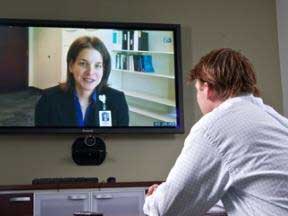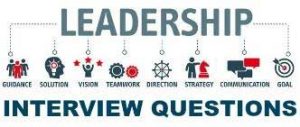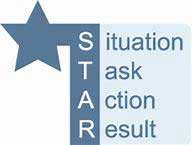With more people working remotely, many of us have experienced a video job interview or conference interrupted by hungry kids demanding snacks or pets in the picture – punctuated by doors slamming, people walking by and ice makers grinding in the background. Or perhaps worst of all, technical problems. We all understand, of course, as we are working from home, too. Welcome to the new world of remote work, pandemic style.
Before coronavirus hit, about 5 percent of U.S. employees reported primarily telecommuting, while 40 percent worked from home at least some of the time. Now, with the pandemic shuttering workplaces, that figure has skyrocketed globally and will most likely continue to remain high in the coming years.
A GUIDE FOR THE VIDEO JOB INTERVIEWS: THE INTERVIEWER

Video job interviews are becoming a common part of the hiring process for most companies, especially in today’s remote working environment. We could call it online, virtual, distance, digital or remote video interviewing. Research shows peopleat most age levels are more knowledgeable on the digital front in their personal or social media life, but more face-to-face in their work environment. That is about to change drastically over the next several years due to the current remote working environment occurring across the globe. These interviews can take several forms. If you have one coming up, it’s a good idea to familiarize yourself with all the variables so you can be prepared.
In this guide, we’ll walk you through all of the variables of video job interviews for the interviewer,
how to prepare the equipment and set up, and how to prepare yourself for the interview utilizing: candidate’s CV, external recruitment firm’s candidate profile, the company position description, a job core competency chart, online psychometric assessments, evaluation forms and matrix candidate comparison charts. And finally, the actual video interview with questions and some suggestions.
The Preparation: The Video Equipment and Interview Preparation
If you have a video interview set up in your office or conference room, make sure you understand how to use it properly and easily without anyone’s assistance. If you operate remotely, you can use your laptop as many have a camera already built -in or you can utilize a desktop computer with a separate camera and a larger screen to conduct the interview. All these devices need to be connected to high speed internet at work or home. There are many interviewing software (Montage, RIVS, Spark Hire, etc.) and communication (Skype, Zoom, Whatsapp, Google Hangouts, etc.) apps available.
The technical preparation and what people are used to seeing on TV

- At work or home, find a quiet, private, well-lit place, free from interruptions or telephone calls.
- Ensure your internet connection has bandwidth speed of at least 1 megabit per second & is stable.
- Close any unnecessary web browser tabs and applications.
- Test your computer’s audio and webcam (video) to ensure it is working before making or receiving a call.
- Check any headphones with a built-in microphone or headphones and a separate microphone.
- Position your webcam so that you have a neutral background that is free from distractions.
- Focus your picture so you are looking into the center of the screen for eye-contact and you are seen from your hands up to above your head – for body language purposes. Use hand gestures when appropriate. When listening, nod and smile to show you are engaged.
- Let the candidate know how you will be dressed.
- Before the interview make sure you have the candidate’s telephone number in case of any problems.
A GUIDE FOR THE VIDEO JOB INTERVIEWS: THE INTERVIEWER
The actual interview material preparation- review and use during the interview

- Assess the candidate’s CV: technical competency and managerial experiences relevant to the position.
- Review recruitment firm’s candidate profile and consultant’s comments on technical & managerial experiences.
- Be familiar with the position description the candidate has been reviewing & discussing with recruiters.
- Utilize and/or develop core competency chart of critical competencies for this position.
- Review online psychometric assessments, if utilized, and address any areas of concern.
- Utilize a corporate or develop your own evaluation form for the interview.
- If you have multiple candidates you could hire, develop a matrix of the candidates for comparison purposes.
The Interview: An Overview of the Video Interview
Companies do video interviews for many of the following reasons:
- Helps to reduce time-to-hire depending on the availability of the team; however, the video makes it more accessible for a remote team or one dispersed due to work schedule, multiple locations with shared services.
- Helps to reduce hiring cost…so many indirect costs would be saved if effectively utilized on internal and external search projects.
- Can automate the screening process for multiple roles, especially if you are not an experienced interviewer.
- Could help to further standardize the company’s hiring processes.
- Helps to align the interviewer with the hiring team in the recruitment process.
- Would help to eliminate bias to a degree as the interview would be very structured with limited casual discussion typically.
- Could improve the quality of hire, as there would be some additional structure in the hiring process.
Video interviews can be used in many ways and different stages of the recruitment process:
- Screening Interview – this could be where you, the hiring manager, have been given a CV from HR of a very qualified potential candidate, they have screened, for a position you have open. They would like for you to conduct a video interview of the potential candidate to see if it makes sense to bring them in for a face-to-face or to video interview with other team members.
- Qualifying Interview – when working with an external search firm and they present a slate of what they think are qualified candidates and you would like to clarify yourself validity of one or two is a good time to conduct a video interview.
- Secondary Interview – if a slate of candidates has been interviewed by most of the key members of the hiring team, but one member was unable to be there or works remotely, a video interview would be a timely, cost-effective response.
- General hiring via video Process – now that the video interviewing process will become more heavily utilized in the employment process, it is perceived the entire process can be utilized to hire the person without the person having a face-to-face meeting with the hiring manager or HR. The new digital hiring age coupled with AI.
- Executive Hiring – on executive positions the push for face-to-face is much more highly desired due to the cultural and relationship aspects of the interaction of the hiring team. That said, video interviewing could be very easily utilized in the vetting process of this ever-evolving approach to interacting with candidates or potential employees.
The Actual Interview
Video interviews can be just as effective as face-to-face interviews, if both parties can relax and forget they are on “television.” Knowing your set up is working properly goes a long way to that relaxed feeling!

Now that your equipment is all set up, the type of interview to be conducted is determined, and the various documents for reviewing and discussing the position are prepared and accessible, the only thing left to do is to conduct the actual interview! Remember you have the candidate’s CV, recruitment firm’s candidate profile, the position description, core competency list you developed, an evaluation form and maybe a psychometric assessment to help you to develop the questions you deem appropriate for the position and this candidate. Also, always remember you are convincing the candidate they can have a successful career at your company!
A GUIDE FOR THE VIDEO JOB INTERVIEWS: THE INTERVIEWER
Here are 10 questions you can use to get your focused list of questions started – also see the list of behavioral questions that could be worked into the discussion.
- Why you are interested int his position?
- Describe how your previous work experience has prepared you for this position. Please be specific.
- How do you feel your professional and educational background has prepared you for this position?
- Although we have reviewed your resume and have been briefed on your qualifications, would you tell us a little bit more about your professional background and interests?
- What are your three main professional goals for the next five to ten years?
- What are your biggest work-related accomplishments? How were you able to attain them?
- What are your biggest work-related failures? Why did they occur? What have you done to prevent them from recurring?
- What are two difficult problems you have encountered in your previous positions? How did you solve them?
- What strategies do you use to anticipate problems? Give an example. If a problem arises that you have not anticipated, how are you likely to handle it? Give an example.
- Can you give an example of creative problem solving from your past work history?

When companies hire executives, a vast majority of employers look for cultural fit over skills. A recent study of 1,200 of the world’s leading companies showed that 88 percent of them focus on a select number of common personality traits. They look for leadership traits and a successful track record that would be a strong organizational/cultural fit, and with many of the following personality traits: mentoring, listening, empowering, Intellectual Curiosity, Self-Monitoring, Confidence, High Energy, Strategic “Smarts” and Professionalism. Executive search interviews are usually more behavioral assessment of an individual’s career.
Utilizing the STAR interview method for behavioral interviews: – unlike traditional questions, behavior job interview techniques look for concrete examples of skills and experiences related to the position. Four key elements of STAR method:

Describe the situation.
What was your task in this situation?
What did your actions lead to?
What were the results?
For each of the following questions, let the candidate give you the background to the story briefly utilizing the STAR points, with specific actions they took and the results.
- Tell me about a time when you handled a challenging situation.
- Tell me about a time when you made a mistake. What did you do to correct it?
- Tell me about a time when you were in conflict with a peer and how the situation was resolved.
- Tell me about how you work under pressure.
- Give me an example of how you set goals.
- Give me an example of a time you made a decision that was unpopular and explain how you handled implementing it.
- Share an example of how you were able to motivate a coworker, your peers or your team.
- Tell me about a goal you set and reached and how you achieved it.
- Tell me about the last time your workday ended before you were able to get everything done.
- Tell me about a goal you failed to achieve.
Let’s face it, we are in a digital age and need to take advantage and be effective with the tools it provides. I hope this guide gives a quick review of how to utilize video job interviewing in your everyday business lives. The current global situation makes us all aware how video communication connects us all in work and play and will continue to be a bigger part of our life going forward. Enjoy and hope this guide is of value!





